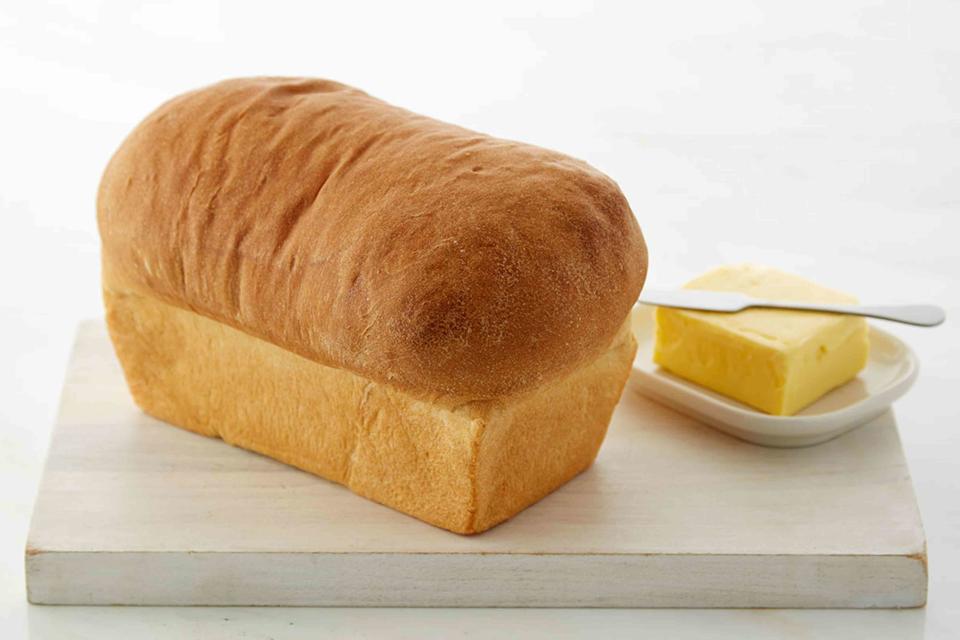The Crucial Difference Between Bread Flour and All-Purpose Flour—and How It Impacts Your Baked Goods
Using the right flour is the key to better breads.

Mike Krautter
When cooking savory foods, you can often get away with substituting ingredients or loosely following a recipe (or foregoing one altogether). But when it comes to baking, experts know how important it is to follow the recipe. That means no estimating measurements, no swapping ingredients, and generally, no substituting one flour for another. If you want your baked goods to come out of the oven with the proper weight, texture, and flavor, it’s important to remember that not all flours are created equally. For baking bread at home, there are two main flours to consider—bread flour and all-purpose flour. But what’s the difference between the two? We spoke to an expert to help break it down.
Meet Our Expert
Melanie Wanders, research and development specialist in the test kitchen at King Arthur Baking Company
Related: 5 Most Common Types of Flour—and How to Sub One for Another
What Is Bread Flour?
Bread flour is a flour with a higher protein content than all-purpose flour, and when you mix the flour with water, the proteins activate to form gluten, says Melanie Wanders, research and development specialist in the test kitchen at King Arthur Baking Company. Gluten gives the dough extensibility (the ability to stretch) and elasticity (the ability to retract or shrink back), she says. Wanders explains that bread flour tends to make yeast-raised baked goods rise higher, especially ones that contain whole grains.
Bread flour typically has a protein content of between 12 to 14 percent, which means it's great for baking bread that you want to be chewy, stretchy, and lightweight, like pizza or focaccia. "Bread flour has more extensibility and elasticity than all-purpose flour because of the higher protein content,” says Wanders.
What Is All-Purpose Flour?
Wanders describes all-purpose flour as the workhorse of the baker’s pantry. “You can use it for anything from pie pastry to cookies, scones to some breads,” she says. It typically has a protein content of 11.7 percent, which means it’s not as glutinous as bread flour. All-purpose flour is made from a mix of hard and soft wheat and is relatively bland and neutrally flavored. Baked goods made with all-purpose flour generally take flavor from other ingredients in the recipe, like yeast, sugar, salts, or fats.
"As the name states, all-purpose flour is just that: all-purpose," says Wanders. That means you can use the versatile ingredient to make pancakes, bread, cookies, or cakes. It's also great in savory applications to make a roux for pan sauces or gravy. Although it's not the ideal flour for every type of baked good, it’s a multifunctional ingredient that's an essential in every home kitchen.
Key Differences Between Bread Flour and All-Purpose Flour
"The biggest difference between bread flour and all-purpose flour is the protein content," explains Wanders, with bread flour having a higher protein content than all-purpose flour. The higher the protein content of the flour, the "thirstier" the flour is, meaning the more water it will absorb, she says. Since protein directly activates to form gluten, the higher the protein content of the flour, the more glutenous the baked good will be. When compared to all-purpose flour, “bread flour tends to impart a chewier texture to baked goods,” says Wanders.
When to Use Bread Flour
Bread flour is great for recipes that you want to be chewy or stretchy. That means bread but also pizza dough, soft pretzels, breadsticks, pita bread, and focaccia are great uses of bread flour.
When to Use All-Purpose Flour
All-purpose flour is ideal for making tender, multipurpose baked goods instead of chewy ones. Use all-purpose flour for muffins, cakes, biscuits, pie crust, and banana bread.
Related: The Best Way to Store Flour, Sugar, and Other Baking Staples to Keep Them Fresh
What to Consider When Choosing Between Bread Flour and All-Purpose Flour
Before selecting the right flour for your baked goods, consider what texture you're hoping for it to come out with. Wanders also suggests strictly following a recipe when baking. "For best results, we always recommend using the flour called for in the recipe," she says. "Most often, the recipe developer has chosen that flour specifically for the characteristics it brings to the recipe, and the recipe has been formulated (specifically hydration and mixing-wise) for that type of flour," she adds.
While both flours are easy to find at a standard grocery store, all-purpose is generally a little cheaper than bread flour.
Substituting Bread Flour for All-Purpose Flour
When substituting bread flour for all-purpose flour, you can substitute at a 1:1 ratio. “If the dough seems slightly dry, try adding 1 to 2 teaspoons of additional liquid to the recipe per 1 cup of bread flour used,” says Wanders.
Keep in mind that when making substitutions, the finished texture might be different. Cookies made with bread flour rather than all-purpose flour will most likely be slightly chewier, less tender, and more “bendy” than their all-purpose flour counterparts, says Wanders.
Related: How to Use Gluten-Free Flour in Place of Regular Flour, According to Experts
Read the original article on Martha Stewart.

